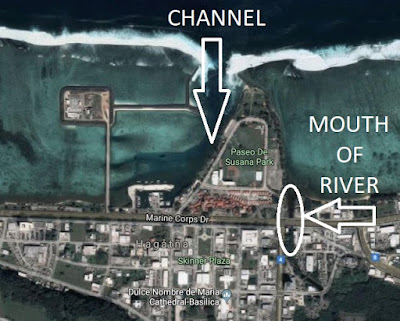In July of 1902, Vicente Taitano de Borja, a leading citizen of Sumay, took in a Chilean guest named David Soto.
Soto was a member of a sailing crew. There were other sailors from Chile with him on their stopover at Guam. For whatever reason, Borja and Soto became acquainted and Borja welcomed Soto into his home for three days. After weeks or months on the high seas, I'm sure several days of rest and entertainment on land was a welcome relief for Soto.
On the third day, a Sunday morning, at around 6AM, Soto asked Borja if he could borrow his boat. He wanted to go to Punta Piti, the usual place people landed when they wanted to go to Hagåtña, the capital city. Borja lent him the boat.
At 9AM, Soto was joined up now by another Chilean shipmate, one Miguel Mendoza. They left Punta Piti in Borja's boat, headed back to Sumay. Perhaps Soto wanted Mendoza to join him in Sumay for a day of fun or adventure.
Punta Piti (right) and A'papa (Cabras) (left)
Half-way to Sumay, a strong wind knocked the boat over, and both Soto and Mendoza fell into the waters of Apra Harbor. They struggled for two hours, hanging onto the capsized boat. After around 2 hours in this situation, Mendoza dove under the boat, we assume to try and push it back up from underneath. But he never resurfaced. Not long after, Soto managed to get the boat upright, though it was full of water. He got to shore and found a
talayero, a man fishing with a
talåya net, who took Soto in his small canoe to Piti to report the incident.
Naturally, the government authorities had to keep open the possibility that there was foul play, since they had only Soto's version of events. But the next morning, a government party found Mendoza's lifeless body washed up at Leyang, a location on Cabras Island (called A'papa in Chamorro). An autopsy performed later that day showed that there were no signs on Mendoza's body of a fight or struggle. There were only two superficial wounds, one of his left shoulder and another on his left ear, both easily caused by rubbing against coral rocks in the harbor.
Mendoza's decaying body was quickly buried at Pigo' Cemetery that same afternoon by Padre Palomo.
The only wrinkle in the story is that a third Chilean sailor, Francisco Carceles, was interviewed and said that Soto was a drunkard and a troublemaker, while Mendoza, the dead man, was not a drinker and not a troublemaker. But the physical evidence showed that, in Soto's case, being a drunkard and troublemaker do not necessarily make one a murderer.
Vicente Taitano de Borja
The boat owner, Vicente Taitano de Borja, was also interviewed. The judicial proceedings in those days were done in Spanish, with interpreters provided for those who needed one. Borja didn't need an interpreter; he understood Spanish. He testified that Soto had asked to borrow his boat, and that, up till then, Borja had not gotten his boat back. It was still in the harbor.
I hope he eventually got it back.
RIP Miguel Mendoza. A Chilean's bones reside in Pigo' Cemetery.
VICENTE TAITANO DE BORJA
Born in Hagåtña, a resident of Sumay.
He was the son of Gregorio Guerrero de Borja and Alejandra Luján Taitano.
He was a
Cabeza de Barangay (neighborhood leader) in Sumay for a while.























